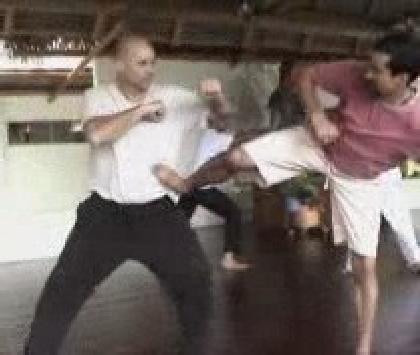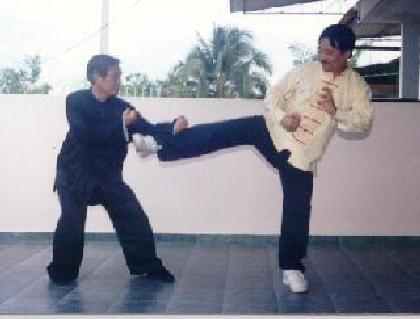QUESTIONS ON TAOIST PHILOSOPHY AND THE CONCEPT OF OPEN AND CLOSE

In a regional Taijiquan class in Costa Rica in February 2005, Diago of Colombia uses a side kick against Ron of the United States, who advances as a Boxer. The force executed in this kick is derived from the concept of “close to open”.
Questions on Taoist Philosophy and the Concept of Open and Close
The classics mention “Eight Doors Five Steps”. Somehow, I don't think this refers to a simplistic reference to eight techniques and types of jing4, and five directions. Sifu, does this reference mean that Taijiquan encapsulates the combat theories of Baguazhang and Xingyiquan (which is based on the Five Processes)? Taijiquan has been described as the “mother” of the other two internal arts, which I feel is somewhat presumptuous.
Zhang Wuji
Sifu's Comments
All the three arts of Taijiquan, Baguazhang and Xinyiquan use the Taoist (or Chinese) philosophy of “yin-yang”, “bagua” and “wu xing”. Mainly for this reason, these three arts are often lumped together as Taoist martial arts or Wudang martial arts.
While there is justification to call them Taoist arts, I believe it is a mistake to call them Wudang arts. Except for Taijiquan, there was no direct connection between Baguazhang and Xingyiquan with the Wudang Mountain. Baguazhang was developed on Jiuhuashan (Nine-Magnificence Mountain) and Xingyiquan by Marshal Yue Fei in the army.
It is historically inaccurate to call Taijiquan the “mother” of the other two internal arts. Xingyiquan is the oldest. Although Baguazhang is younger than Taijiquan, their basic philosophy (though both are Taoist) and techniques are quite different.
Wong Kiew Kit
 An effective counter against a side kick is the pattern “Sun and Moon Shine Together” from Wuzu Kungfu, which is similar to “Immortal Pounds Mortar” in Taijiquan. Here the force is executed from the concept of “open to close”.
An effective counter against a side kick is the pattern “Sun and Moon Shine Together” from Wuzu Kungfu, which is similar to “Immortal Pounds Mortar” in Taijiquan. Here the force is executed from the concept of “open to close”.
Sifu, I would like to know more about the concept of “open” and “close” in Taijiquan. Some Yang masters have used the phrase in the classics “Gathering jing is like pulling the bow, exploding it is like releasing the arrow” to explain. There is an opening movement in preparation for a strike (yin) while the actual strike sees the whole body closing up and compressing to deliver the energy (yang).
Some other masters have said that “opening” refers to the physical action of extending the limbs and sending the qi outwards, while “closing” refers to bringing the arms or legs back to the body, and sending the qi back to the dantian. I am confused by this apparent contradiction, but I suspect this is a case of using the same words “open and close” to refer to two different matters. I always find Sifu's exposition of the yin-yang theory most enlightening and this seems to be another aspect of yin-yang.
Zhang Wuji
Sifu's Comments
Words are used provisionally, i.e. the meaning is provided for the occasion only. Hence, the meaning of a word used in one occasion may not be applicable in a different occasion. For example, we say that Taijiquan is practiced slowly. Here the word “slowly” is used provisionally. There are also occasions when Taijiquan is practiced fast.
Secondly, the meaning of a word is limited to one's experience and interpretation. The same word “slowly” may carry different meanings for different people.
In the above examples of “open” and “close”, you are right in saying they refer to different matters in different situations. The “opening” in pulling a bow to gather force is different from the second “opening” in extending the limbs.
Moreover, there are also different ways of gathering and exploding force. One may gather force by extending the limbs, like pulling a bow, then explode it by compressing the body, like releasing an arrow. On the other hand, one may gather force by compressing the body to focus on the dan tian, then explode it by extending the limbs to send the force out.
Wong Kiew Kit
- The Evolution of Taijiquan from Shaolinquan
- General Practice and Training, and Sparring Methodology
- Combat Philosophy on Retreat and Yielding
- Difference in Stances
- The Use of Internal Force
- Fa-jing and Qin-na
- Academic Questions and Direct Experiences
- Yin-Yang, God and Health
- Spirituality and Over-Training
- Questions on Sinew Metamorphosis
- Questions on Breathing Methods and Control
- Taoist Philosophy and Concept of Open and Close
LINKS
